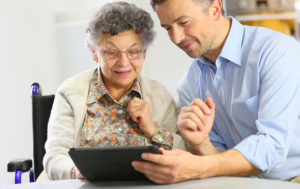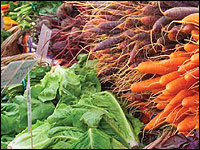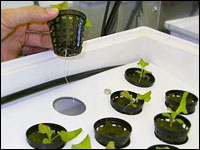‘DNA Printing’ in the Cloud, Part 1
‘DNA Printing’ in the Cloud, Part 2
DNA printing has given rise to the world’s first “DNA printer” on the market, a claim advanced by the product’s creators. The BioXp 3200 System is available from SGI-DNA, a division of Synthetic Genomics, a San Diego biotechnology company.
The BioXp 3200 System is a DNA/RNA assembler and synthesizer made out of steel, glass, plastic, insulated wire, laboratory instruments and microprocessors. The system is about the size of a business office network laser printer, but instead of outputting printed hard copy, this device copies genes and outputs proteins.
The BioXp 3200 is a benchtop automated personal genomic workstation that provides researchers with applications in synthetic biology, including protein production, antibody library generation and cell engineering, according to its manufacturer.
With its assembly-and-cloning module, the BioXp system can generate linear DNA fragments from custom-designed pools of “oligo” (short fragments) nucleotides and reagents (biologically active substances), and can deliver cloned DNA from a custom DNA sequence in an overnight run.
The process utilizes Gibson Assembly, an industry-standard molecular cloning method that allows the joining of multiple DNA fragments in a single, isothermal (constant temperature) reaction.
The system is cybergenomic and cyberproteomic — each BioXp unit is equipped with an onboard computer connected to the Internet. The process starts with sequence data electronically transmitted from anywhere in the world.
SGI-DNA customers begin by placing their order and uploading their sequences to SGI. SGI will build and deliver custom kits to customers who, once they receive a kit, load the deck and close the instrument.
An onboard camera reads the bar code on the reagent package and pulls the appropriate optimized protocol from the cloud. DNA assembly begins, and runs generally take between 12 and 17 hours, depending on the precise nature of the construct being synthesized — an artificially constructed segment of nucleic acid (DNA) that is to be transplanted into a target tissue or cell for protein production.
Dandelion Synthetic Rubber – OSU
The modern world runs on natural rubber, an indispensable commodity in ever shorter supply.
About 70 per cent of natural rubber latex is used for vehicle tires wrapped around the wheels of cars, trucks and bicycles, according to Rubber World Magazine. Other products made of natural rubber include mattresses, condoms, shoe soles, hot water bottles, balloons, rubber boots and seal rings. Natural rubber can be substituted by synthetic rubber for some applications, but airplane tires, for instance, would explode upon landing if made of synthetic materials.
The major commercial source of natural rubber latex is the Par rubber tree (Hevea brasiliensis), a member of the spurge family, Euphorbiaceae. This species is preferred because it grows well under cultivation. A properly managed tree responds to wounding by producing more latex for several years.
Although the rubber tree is native to South America, only 3 percent of the global natural rubber production took place in all of North, Central and South America as of 2016. The vast majority of natural rubber is produced in Asia.
However, a global natural rubber shortage is looming. World consumption of natural rubber grew 5.2 percent in the first seven months of 2018, compared with growth of 3.7 percent in world natural rubber supply, according to the Association of Natural Rubber Producing Countries (ANRPC).
Natural rubber production has been impacted negatively not only by cyclical market prices, but also by environmental conditions such as climate change, leading to both flooding and aridity, plant pests and disease, and deforestation. Rain forests are being felled at an alarming rate to provide plantation acreage for growing rubber trees.
Alternatives to durable, reliable natural rubber are being sought, and one solution is dandelions.
OSU Bio-Emergent Materials
Katrina Cornish is the endowed chair and Ohio scholar in bio-emergent materials at the Ohio State University’s Ohio Agricultural Research and Development Center (0ARDC) in Wooster, Ohio.
Cornish heads up the Cornish Lab, where breeding and development work has been carried out on Taraxacum kok-saghyzis, or TK,a species of dandelion native to Kazakhstan in the Russian steppes. TK is a plant notable for its production of high quality rubber. Latex produced in the roots of the plant has properties very similar to Hevea rubber latex.
The lab does direct manipulation of the plant’s genes with novel genetic engineering techniques, using the SGI-DNA BioXp 3200 DNA printer for gene insertion and editing.
In a February 2018 study, Cornish and OSU colleagues described the hybridization potential between TK and the common dandelion Taraxacum officinale, or TO, which required the use of recombinant DNA technology.
The Cornish lab has partnered exclusively with American Sustainable Rubber (ASR) to develop a hybrid cultivar of the TK dandelion that is genetically engineered to be grown year-round indoors domestically, utilizing commercial scale vertical hydroponic (liquid nutrient) controlled environment agriculture (CEA) technology.
The goal of the lab’s joint research with ASR on the TK dandelion is to achieve an increase of natural rubber content from the current level of less than 10 percent to more than 20 percent in the dry dandelion root mass, effectively reducing the required size and upfront capital investment and annual operating expense of a commercial-scale production facility by more than 50 percent, while simultaneously improving annual production efficiency and profitability.
“Once we understand the regulatory bottlenecks that limit the amount of rubber my rubber dandelions make, we may be able to use this technology to open them up and improve rubber yield while still producing a healthy crop,” Cornish told TechNewsWorld.
Lettuce Vaccines
Influenza, a viral disease passed from person to person by contact with respiratory droplets, typically is treated in advance of infection with vaccines used as a preventive measure to confer immunity against the flu virus.
Like all disease-bearing organisms, flu viruses produce antigens — foreign particles, usually proteins, capable of generating in the body immunogenicity — an immune system response.
The body’s immunogenic response consists of specific antibodies generated by plasma cells as a result of exposure to precise portions of the antigen called “antigenic determinants,” or “epitopes.” These small, specific portions of antigen are recognized by immune system elements, primarily antibodies — blood proteins produced in response to and counteracting a specific antigen.
A single antigen usually displays several different epitopes. The region on an antibody that recognizes a particular epitope is called its corresponding “paratope.” Antibody paratopes fit exactly with and bind to specific antigen epitopes.
In the past, the U.S. Food and Drug Administration (FDA) required that flu vaccines be developed using fertilized chicken eggs as hosts for growing the influenza virus. That is no longer the case.
One post-egg technology for flu vaccines approved for use in the U.S. market in 2013 involves using recombinant protein technology. This rDNA vaccine production method does not use chicken eggs at all in the process. Instead, manufacturers isolate a certain gene (the hemagglutinin “HA” or neuraminidase “NA” gene) from a naturally occurring, or “wild type,” recommended vaccine virus.
Flublok from Sanofi Pasteur, approved by the FDA for use in persons 18 years of age and older, is a vaccine containing recombinant proteins indicated for active immunization against disease caused by influenza A virus subtypes and influenza type B virus contained in the vaccine.
Flublok is made by taking the genetic information from one HA flu virus protein and putting it into cultured cells that are grown in stainless steel tanks.
Viral vaccines also can be plant-made, or “biofarmed.”
Plant genetic engineering technology was established decades ago, but now biofarmed pharmaceuticals and vaccines are fast approaching commercialization.
Plant genomics is the part of molecular biology working with the structure, function, evolution and mapping of genomes in plants. Although plants are more difficult to work with than bacteria, gene insertions can be made into single plant cells, and the cells then can be cultivated to form a mature plant.
The major method for inserting genes into plant cells is through the use of plasmids, replicating bacterial DNA segments outside of cell chromosomes.
Transgenic plants are plants that have been genetically engineered, a breeding approach that uses recombinant DNA techniques to create plants with new characteristics. They are identified as a class of genetically modified organism (GMO).
Lettuce (Lactuca sativa L.) is a globally important leafy vegetable that has been used in research on the stable expression of transgenes. Lettuce transgenic research carried out so far has focused mainly on improving the nutritional and physiological value of lettuce.
Now lettuce has joined plants like tobacco and potatoes, commonly used as bioreactors producing pharmaceutical protein and vaccines.
In the process of recombinant protein technology, an HA or NA gene is combined with portions of another virus that grows well in lettuce cells as a host for gene introduction. This is achieved in vitro in the laboratory by using tissue cultures of plant stem cells in order to produce a desired protein.
Vaccines derived from this recombinant virus method contain an agent that resembles the disease-causing microorganism antigen and often is made from weakened or killed forms of the virus, its toxins, or one of its surface proteins. The lettuce leaves carrying the biological vaccine substance then are freeze-dried and processed into capsules containing vaccine-laden lettuce leaf powder.
Organic Genomics Inc.
Ohio-based Organic Genomics Inc. (OGI) has submitted a proposal for utilizing the SGI-DNA BioXp 3200 system to the Universal Influenza Vaccine Development Grand Challenge, a program backed by the Bill & Melinda Gates Foundation and Google’s Larry Page.
The Gates Foundation and Page have offered up to US$12 million in funding as part of a 2018 initiative to support the development of a universal influenza vaccine. The program seeks to fund novel concepts that reduce flu’s global death toll and substantially mitigate the persistent global pandemic flu threat.
DNA, through RNA, codes for the sequence of amino acids in a polypeptide chain that forms a protein. A peptide is a compound consisting of two or more amino acids.
Peptide vaccines are an attractive alternative to conventional vaccines, because they rely on the usage of short peptide fragments to engineer the induction of highly targeted immune responses, consequently avoiding allergenic and other adverse reactions (e.g., fever).
Peptides used in these vaccines are 20-30 amino acid sequences that are synthesized to form an immunogenic peptide molecule representing specific epitopes on the target antigen.
OGI has taken a novel approach to combating influenza with a “multi-valent peptide vaccine” created by genetically engineering hydroponically grown lettuce plants to elicit a greater immune response. These peptides are genetically engineered to target all the various 18 HA and 11 NA viral antigens and their epitopes that make up all influenza sub-types.
Vaccines developed by OGI are designed for oral consumption and can be distributed as capsules consisting of plant-based powder enclosed in a dissolvable gelatin capsule container.
“We are utilizing the SGI BioXp 3200 module to print custom vectors — transporting agents — that we synthesize into lettuce plant stem cells that can be cultured into mature plants exhibiting the ability to biologically produce vaccines,” explained Timothy Madden, CEO of OGI.
“Each head of lettuce serves as its own individual organic bioreactor in which production of the pharmaceutical compound takes place,” he told TechNewsWorld.
A commercial scale production facility could produce millions of doses of specified vaccines annually at a cost competitive with current vaccine production methods, according to Madden, and an encapsulated powder lettuce vaccine could be dry stored at room temperature, making it ideal for shipment and use in developing countries for humanitarian purposes.
SGI DBC
In May 2017, Synthetic Genomics, Inc. (SGI) announced the development and operation of its Digital-to-Biological Converter (DBC) prototype that produces biologic compounds on demand without any human intervention.
The DBC integrates many of the synthetic biology tools developed by Synthetic Genomics for creating complex synthetic DNA, all in one fully automated unit.
One of the main pieces in the DBC is the BioXP 3200 — the company’s synthetic DNA assembler that is already marketed around the world to researchers who use it to create synthetic DNA samples. The rest of the elements in the DBC receive and process information.
“Like a fax machine, our digital biological converter is an instrument designed to receive digitized instructions — in this case, DNA code — and assemble the ‘genetic’ ingredients for medicine production,” said Dan Gibson, Ph.D., vice president, DNA technology, at SGI.
Gibson spilled the beads (pun intended) on how his “biological transportation” concept works in his 2018 TED talk on “How to build synthetic DNA and send it across the Internet.”
“We are working to reduce the size of the current DBC so that one day hospitals around the world can easily ‘print’ personalized medicines for each of their patients, the same way doctors can easily and routinely draw blood or take an X-ray,” Gibson told TechNewsWorld.
The DBC device accepts digital representations of DNA over the Internet and reconstructs them on the spot using the four chemical nitrogenous nucleotide bases found in DNA — adenine, cytosine, guanine and thymine — the DNA building blocks of life derived from phosphoramidite sources.
Just like a printer, the DBC needs cassettes, but instead of containing colored inks, the system uses bottles of chemicals containing synthetic DNA for use in the DNA printing of proteins.





















































